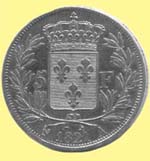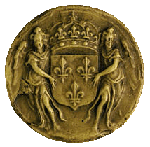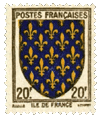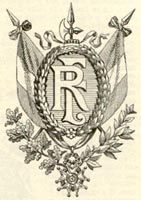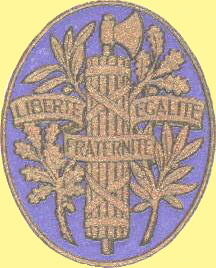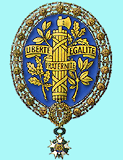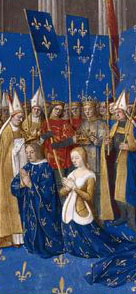
![]()
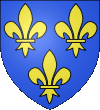
![]()

![]() The
traditional arms of France. Since the late 12th century
the arms of France were "Azure, a semis of fleurs-de-lis
or" - golden fleur-de-lis scattered on a blue background.
In 1376 it was changed to "Azure, three fleurs-de-lis
or" - just three fleur-de-lys arranged two and one.
Ignoring the French Republic, heralds around the world refer
to these two variations of the French arms as "France
ancient" and "France Modern".
The
traditional arms of France. Since the late 12th century
the arms of France were "Azure, a semis of fleurs-de-lis
or" - golden fleur-de-lis scattered on a blue background.
In 1376 it was changed to "Azure, three fleurs-de-lis
or" - just three fleur-de-lys arranged two and one.
Ignoring the French Republic, heralds around the world refer
to these two variations of the French arms as "France
ancient" and "France Modern".

![]()

![]() Until
1801 the Kings of England claimed the French throne. Since
France was regarded as the senior kingdom, they quartered
the arms of France and England with France in the first
quarter. When the French kings changed their arms, the English
kings did the same thing (around 1405). The arms of France
modern still appear today in the full achievement of arms
of Canada - twice. See below left.
Until
1801 the Kings of England claimed the French throne. Since
France was regarded as the senior kingdom, they quartered
the arms of France and England with France in the first
quarter. When the French kings changed their arms, the English
kings did the same thing (around 1405). The arms of France
modern still appear today in the full achievement of arms
of Canada - twice. See below left.
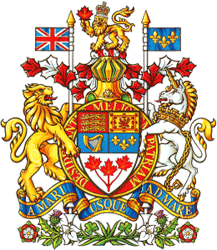

![]()

![]()
![]() The
personal French royal arms were the same, except with a
white (technically silver) background. Showing gold on silver
was a deliberate breach of heraldic convention, emphasising
that the king was above all human law (the Kings of Jerusalem
did the same, and so did the popes - as they still do even
today).
The
personal French royal arms were the same, except with a
white (technically silver) background. Showing gold on silver
was a deliberate breach of heraldic convention, emphasising
that the king was above all human law (the Kings of Jerusalem
did the same, and so did the popes - as they still do even
today).
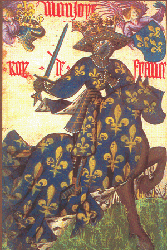

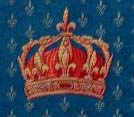
![]() The
medieval crown was open and decorated with fleurs-de-lis
From 1515 representations show a closed crown. Previously
only the Emperor used a closed crown). and it may be that
the reason for adopting a closed imperial crown was the
ceding by Andreas Paleologue (1453-1502), nephew of the
last emperor Constantine XI, of his rights to the Byzantine
empire to Charles VIII, on 11 September 1494. The supporters
were two Evangelists, but from about 1423 they were replaced
by two angels.
The
medieval crown was open and decorated with fleurs-de-lis
From 1515 representations show a closed crown. Previously
only the Emperor used a closed crown). and it may be that
the reason for adopting a closed imperial crown was the
ceding by Andreas Paleologue (1453-1502), nephew of the
last emperor Constantine XI, of his rights to the Byzantine
empire to Charles VIII, on 11 September 1494. The supporters
were two Evangelists, but from about 1423 they were replaced
by two angels.
Click on the following link for more on the
Seal of King Louis IX ![]()
|
|
The Modern Arms of the French Republic. Coats of arms (technically achievements of arms) were associated with royalty and aristocracy, and as such French republicans have always been uneasy about using them. The association with the Ancien Régime is simply too close.

![]()

![]() A
compromise solution is to use arms that deliberately ignore
heraldic convention and that are so mangled that they are
hardly recognisable as arms. The emblem on the left is an
example. It shows a distorted crescent shaped shield (with
a lion's head!) in the centre of the design bearing the
cypher
FR for République Française (French Republic)
- another heraldic infelicity. Until it is pointed out,
or highlighted as on the right, you would be hard pressed
to notice that the lion headed device represents an heraldic
shield.
A
compromise solution is to use arms that deliberately ignore
heraldic convention and that are so mangled that they are
hardly recognisable as arms. The emblem on the left is an
example. It shows a distorted crescent shaped shield (with
a lion's head!) in the centre of the design bearing the
cypher
FR for République Française (French Republic)
- another heraldic infelicity. Until it is pointed out,
or highlighted as on the right, you would be hard pressed
to notice that the lion headed device represents an heraldic
shield.
The symbolism of the other background elements is as follows:
